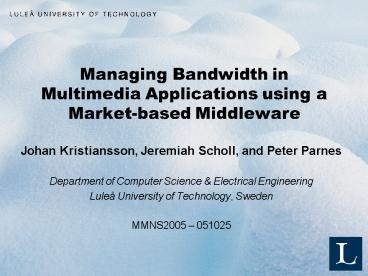Managing Bandwidth in Multimedia Applications using a Marketbased Middleware - PowerPoint PPT Presentation
1 / 19
Title:
Managing Bandwidth in Multimedia Applications using a Marketbased Middleware
Description:
Managing Bandwidth in Multimedia Applications using a Market ... T tonnement process. A t tonnement process is used to adjust the price iteratively until an ... – PowerPoint PPT presentation
Number of Views:70
Avg rating:3.0/5.0
Title: Managing Bandwidth in Multimedia Applications using a Marketbased Middleware
1
Managing Bandwidth in Multimedia Applications
using a Market-based Middleware
- Johan Kristiansson, Jeremiah Scholl, and Peter
Parnes - Department of Computer Science Electrical
Engineering - Luleå University of Technology, Sweden
- MMNS2005 051025
2
Agenda
- Introduction
- Related work
- Market-based bandwidth management
- Overview of the middleware
- Evaluation
- Discussion
- Questions
3
Introduction
- Distributed multimedia applications
- Bandwidth requirements can rapidly change
- Wireless landscape
- Available bandwidth can rapidly change
- How can bandwidth be shared efficiently between
the different media inside a multimedia
application in order to provide the user with the
optimal aggregate experience? - Interdisciplinary knowledge is required
- Networking specialist
- Usability specialist
4
What is this paper all about?
- Middleware framework based microeconomic
principles - Supply and demand
- Management system in the application-layer
- Various solutions related to network management
(usually affecting the supply) and the various
solutions related to usability (usually affecting
demand) to be researched and integrated
separately into an application.
5
Related work
- QoS support in distributed system
- Agile QoS, Q-RAM etc.
- Priced-based Congestion-control
- Market Managed Multi-Service Internet (M3I)
- Deployment issues
- User may find dynamic pricing unacceptable
6
Market-based bandwidth management
- The idea Use microeconomic theory in a virtual
market inside an application in order to make it
easy to combine various network services while
maintaining the efficient use of resources. - Bandwidth is traded by consumers and suppliers.
- Equilibrium is reached when demand for bandwidth
at the going price equals the supply for
bandwidth at that price.
7
The virtual market
Audio
Video
Other
Chat
Broker
WLAN/LTU
UMTS/GPRS
GSM/GPRS
Other
8
Tâtonnement process
- A tâtonnement process is used to adjust the price
iteratively until an equilibrium price is
obtained. - p p
- Over-demand and under-demand
d
s
n1
n
9
Overview of the middleware
Multimedia application
Adapt utility function
Adapt bandwidth usage
Bandwidth Consumer Agent
Bandwidth Broker Agent
Packets
Buy/request bandwidth
Receipt
Bandwidth Broker Agent
Information about demand
Information about supply
Configure
IP Mobility protocol
Network agent
Information About available networks
Configure
Operating system
10
Calculating the supply
- Bottleneck bandwidth
- Budget controls
- Measuring bandwidth
- Pathchar, Packet-Pair algorithm, congestion
control algorithms - Separate markets for separate end-points or
multicast groups
11
Calculating the demand
Utility
- Demand is calculated by creating a utility
function for each media that maps the gain with
different bandwidth levels. - The Bandwidth Consumer Agent calculates the
consumer surplus (CS) in order to calculate the
amount of bandwidth to purchase. - u (x ) p
Utility function, u(x)
Price function, p(x)
CS
Bandwidth
CS
X
CS
m
12
Evaluation
- Proof of concept prototype
- Marratech Pro
- Audio, Video, chat, WB, Web, remote desktop
sharing - Packet distribution
- IP multicast or an E-meeting Portal (unicast)
13
Experiment setup
Client A
Client B
Marratech Manager
- Two Marratech Pro clients
- Client A used the prototype.
- Client B was only used to change level of
incoming to traffic - Supply
- S s - bw , s 100
kB/s - Utility functions
- Audio u (x) 0 xltx or
infinity xgtx - Video u (x) ln(1 x) gt x (p)
-1
limit
received
limit
min
min
audio
audio
audio
1
video
video
p
14
Bandwidth sharing between multiple media
- Video back off to make room for audio
Audio demand
Video demand
The price goes up
15
Investigation into recalculation rates
- Higher price recalculation rate leads to more
efficient allocation of bandwidth
- Higher supply recalculation rate causes
instability.
16
Utilizing multiple networks
- Test how the system handles large variation in
supply. - Resilient Mobile Socket was used to add mobility
support.
Handover to a GPRS network
17
Discussion
- View bandwidth as a universal commodity
- Use virtual price/market to share bandwidth
- Each component can contribute to the equilibrium
separately - Networking specialist can develop better methods
to obtain bandwidth (NA). - Usability specialist can develop new method to
utilize bandwidth by defining utility functions
(BCA).
18
Discussion
- Possible to allocate bandwidth close to an
equilibrium allocation by using a high price
recalculation rate and a low supply recalculation - Future work
- Use a real congestion control algorithm
- More effective utility functions
- More sophisticated experiments.
19
Questions?
- Contact information
- johan.kristiansson_at_csee.ltu.se
- http//www.csee.ltu.se/johank
- Visit this page for contact details
- The media technology research group
- http//media.csee.ltu.se

